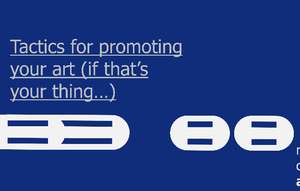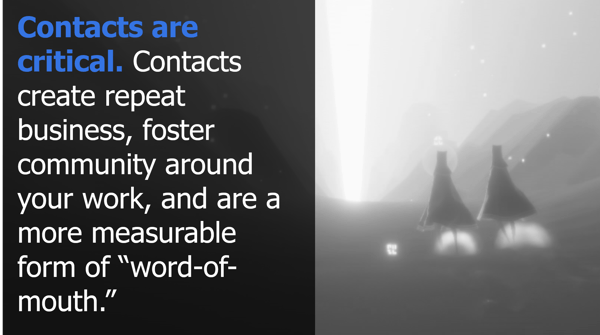
How often do you think about the marketing, promotion, and sales aspects of your art? Maybe 5% of your day?
No matter your craft, you'd likely prefer to buckle down and create, rather than contemplate how to approach running your creativity like a business.
Turns out, that's the right attitude, and with this guide on the must-do marketing and sales tactics, you can know which actions to prioritize, leaving you more time to do what you love...
no. 1) Your website is your storefront.
It needs all the things a physical storefront needs. It needs paint, signage, and a big 1-sentence subheader that's part tagline for humans and part guidepost for search engine algorithms.
For instance, Ghost Little's welcoming header reads:
"Ghost Little is a series of free books."
Enough to catch an eye, enough to explain the site's parameters, enough to snag some SEO ranking, and enough to tell visiting clientele the type of work you do.
More tips for establishing your storefront:
- A clear sign—this is your logo
- A clear description—on your homepage, in as few words as possible, express your business’ mission why it’s important, how you do it, what the end result looks like
Do you have consistent products / performances / packages? You won't put pricing on the homepage, but if there are key services you deliver or mediums you work in, feature them in writing, which is critical for SEO (more on that in item 5 further down).
no. 2) Your storefront cannot look abandoned.
You need to have the digital equivalent of a person who can approach window shoppers. Include a mechanism to engage with them, even on the homepage. Options range from high-tech chatbots, or just including the right info. You want to answer visitors' questions. You want to discover if they're in the right place, and if they still aren't sure, you want to hold a longer conversation with them to convince them otherwise.
On the most basic level, you can achieve this by:
- Including a Contact Us form where visitors can let you get back to them (add it to your top navigation bar)
- A Contact Form lets the visitor fill in their name, contact info, ask any upfront questions you feel are important to beginning the conversation
- Gravity Forms are a great solution for small operations, they're $39 a year
Ghost Little features a downloads page that contains the library of free books we offer. Once a visitor picks a book from there, they're treated to a preview, then an opportunity to download the ebook file, volunteering to share their contact info in the process.
Alternatively, they can sign up for the blog subscription if they aren't ready for the free books, but want to watch things develop.
no. 3) How much do you need to keep in touch with visitors to your store (website)?
Probably a lot. If you're nurturing a library of your work, or sharing updates, or announcing a show or exhibit, you need to tell everyone that's ever show interest in your work.
You need to invite conversation with anyone who has visited your site and shared their contact info, hence the necessity of a first-touch contact form.
Here's some fast math:
- Let's say 1000 people visit your website in a month. 10 of those people fill in a contact form. 1 of those people becomes a patron of your work.
- However, those other 9 people that filled in your contact form may be interested in your work next month, or next year. You need to remind them a regular (but non-intrusive) basis what you'er about, and that you and your work continue to exist. What's more, if next month, you get the same (or more) visitors, contacts, and clients, you suddenly have 18 people you'd like to keep in touch with!
- You can manage a prospective patron list of 9 people, but when it gets up to 45, or 99 in a few months (ideally!) it may require an emailing tool to keep in touch with those folks.
Constant Contact is a small email-automation tool that can help with this. Ghost Little uses HubSpot for all website, social, contact, and email tools to make announcements and distribute the free books. It's a more holistic, robust tool, just make sure you're using the right-sized solution.

As for contacts, it cannot be stressed enough—contacts are your goal (along with patrons) because:
- Contacts let you generate repeat business
- Contacts let you earn a specialist notoriety
- Contacts are people you can count on for testimonials and support to gather more prospective clients, segueing nicely into item number 4
no. 4) How much proof of concept do you need for your business?
Again, probably a lot. Art can gather a large following in grassroots, but intelligent people with good taste attract like-minded folks. You want testimonials of shows, quotes from fans, promotions, and even case studies, when relevant:
- Go back through your successes, exhibits, or work samples, and build a portfolio
- Gather specifics and referrals with those you've collaborated with
- Work with them to tell a story about how you helped them
- Take those stories, written, videoed, as specific or non-specific as you like, and create pages for them on your site
- This is going to strengthen your case with window shoppers coming to your site, checking to see if you’re the right solution for them
I've written about how to position your creativity as a business in my articles over on The Odyssey. Dig in deeper over there for more on making money off passionate creativity.
no. 5) What do you need to do to your website on a recurring basis to bring people in?
You need SEO (search engine optimization). This is primarily done through blogging to emphasize with a search engine like Google what you're the best at.
In reality, it’s just a set of rules to tell Google what’s on your site and what people can find there.
This case study over on Moz outlines the rules of SEO, and how a company followed a plan and began ranking high in competitive Google search terms in only 3 months, detailing:
- Which keywords to feature on a site (to tell Google what you’re all about)
- How to emphasize those words (imagine it like website interior decoration or feng shui)
- The first tool to use for this is Google Analytics, which is basically site traffic tracking
What else?
This only scratches the surface of what inbound marketing can do for an artistic endeavor. There are even more steps for retaining business and processing payments for work that will have to wait for another day.
You can follow Ghost Little's blog as the free books project continues and track how things develop.
Share around your questions and answers to these larger challenges!

